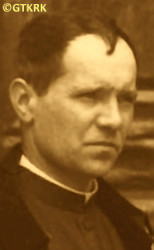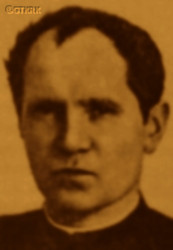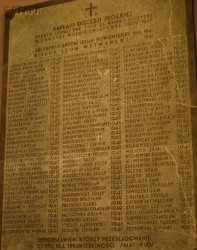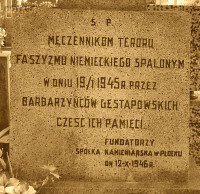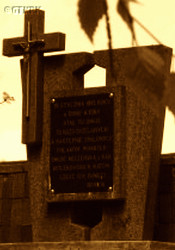Roman Catholic
St Sigismund parish
05-507 Słomczyn
85 Wiślana Str.
Konstancin deanery
Warsaw archdiocese, Poland
full list:
displayClick to display full list

searchClick to search full list by categories
wyświetlKliknij by wyświetlić pełną listę po polsku

szukajKliknij by przeszukać listę wg kategorii po polsku

Martyrology of the clergy — Poland
XX century (1914 – 1989)
personal data
surname
DUBLEWSKI
forename(s)
Thaddeus (pl. Tadeusz)
function
diocesan priest
creed
Latin (Roman Catholic) Church RCmore on
en.wikipedia.org
[access: 2014.09.21]
diocese / province
Płock diocesemore on
en.wikipedia.org
[access: 2013.05.19]
academic distinctions
Doctor of Bible Science
Bachelor of Bible Science
honorary titles
Minor Canonmore on
en.wikipedia.org
[access: 2014.11.14]
(from 03.03.1938, Assumption of the Blessed Virgin Mary RC cathedral church, Płocktoday: Płock city pov., Masovia voiv., Poland
more on
en.wikipedia.org
[access: 2021.12.18])
date and place
of death
19.01.1945

Płocktoday: Płock city pov., Masovia voiv., Poland
more on
en.wikipedia.org
[access: 2021.12.18]
details of death
During Polish–Russian war of 1919‐1921 — as a theology student — ministered as a nurse in the Polish Army (among others on the Polish Red Cross PCK „Łokietek”transport ship used in 1920 to move wounded soldiers).
After German and Russian invasion of Poland in 09.1939 and start of the II World War, after start of German occupation and closure by the Germans of the Theological Seminary in Płock on 09.12.1939 a vicar in Klukowo parish.
In 1943 when his rectory was taken over by the Germans and used as a county administrative center moved to Strzegocin monastery.
Arrested by the Germans on 22.08.1944.
Jailed in Pułtusk.
In 09.1944 moved to Płońsk and next to Sierpc and Płock prisons.
Few days before arrival of the Russian troops — during Russian winter offensive of 1945 leading to the end of the military conflict — murdered and burnt in 28 Sienkiewicza Str. building in Płock, together with c. 98 other inmates.
cause of death
mass murder
perpetrators
Germans
sites and events
PłockClick to display the description, PłońskClick to display the description, Ribbentrop‐MolotovClick to display the description, Pius XI's encyclicalsClick to display the description, Polish‐Russian war of 1919‐1921Click to display the description
date and place
of birth
29.10.1894Birth certification on:
metryki.genealodzy.pl
[access: 2025.03.16]

Prusinowicetoday: Świercze gm., Pułtusk pov., Masovia voiv., Poland
more on
en.wikipedia.org
[access: 2021.12.18]
parents
DUBLEWSKI Vladislav
🞲 ?, ? — 🕆 ?, ?

KACZYŃSKA Anne
🞲 ?, ? — 🕆 ?, ?
baptism
29.10.1894Birth certification on:
metryki.genealodzy.pl
[access: 2025.03.16]

Klukowotoday: Świercze gm., Pułtusk pov., Masovia voiv., Poland
more on
en.wikipedia.org
[access: 2021.12.18]
St Stanislav the Bishop and Martyr RC church
presbyter (holy orders)
ordination
28.06.1924

Lisieuxtoday: Calvados dep., Normandie reg., France
more on
en.wikipedia.org
[access: 2024.03.19]
positions held
1943 – 1944
resident — Strzegocintoday: Świercze gm., Pułtusk pov., Masovia voiv., Poland
more on
en.wikipedia.org
[access: 2021.12.18] ⋄ monastery ⋄ Our Lady of the Scapular RC parish ⋄ Nasielsktoday: Nasielsk gm., Nowy Dwór Mazowiecki pov., Masovia voiv., Poland
more on
en.wikipedia.org
[access: 2021.12.18] RC deanery
1940 – 1943
vicar — Klukowotoday: Świercze gm., Pułtusk pov., Masovia voiv., Poland
more on
en.wikipedia.org
[access: 2021.12.18] ⋄ St Stanislav the Bishop and Martyr RC parish ⋄ Nasielsktoday: Nasielsk gm., Nowy Dwór Mazowiecki pov., Masovia voiv., Poland
more on
en.wikipedia.org
[access: 2021.12.18] RC deanery
from 03.03.1938
Minor Canon — Płocktoday: Płock city pov., Masovia voiv., Poland
more on
en.wikipedia.org
[access: 2021.12.18] ⋄ Cathedral Chapter ⋄ Assumption of the Blessed Virgin Mary RC cathedral church
1930 – 1940
vice–rector — Płocktoday: Płock city pov., Masovia voiv., Poland
more on
en.wikipedia.org
[access: 2021.12.18] ⋄ Theological Seminary
1929 – 1940
professor — Płocktoday: Płock city pov., Masovia voiv., Poland
more on
en.wikipedia.org
[access: 2021.12.18] ⋄ Theological Seminary — lecturer in biblical science, patristics
spiritual father — diocesan Catholic press
friar — Carmelite tertiary
till 1929
PhD student — Paristoday: Paris dep., Île‐de‐France reg., France
more on
en.wikipedia.org
[access: 2020.11.13] ⋄ Institut Catholique (Eng. Catholic University) — PhD thesis on the exegesis of St Augustine, public defense on 19.06.1929, diploma „magna cum laude”
PhD student — Jerusalemtoday: Jerusalem dist., Israel
more on
en.wikipedia.org
[access: 2022.09.31] — biblical studies
from 1925
student — Rometoday: Rome prov., Lazio reg., Italy
more on
en.wikipedia.org
[access: 2021.12.18] ⋄ Pontifical Biblical Institute (Lat. Pontificium Institutum Biblicum), known as „Biblicum” (from 1909) — postgraduate specialised studies crowned with Biblical Science Batchelor's degree
1921 – 1924
student — Paristoday: Paris dep., Île‐de‐France reg., France
more on
en.wikipedia.org
[access: 2020.11.13] ⋄ theology, Institut Catholique (Eng. Catholic University) — also: pastor to the Polish emigrees in Saint–Éloy–les–Mines and La Bouble, in the region of Auvergne–Rhône–Alpes, department Puy–de–Dôme department in France
1919 – 1921
student — Płocktoday: Płock city pov., Masovia voiv., Poland
more on
en.wikipedia.org
[access: 2021.12.18] ⋄ philosophy and theology, Theological Seminary
1916 – 1919
pupil — Płocktoday: Płock city pov., Masovia voiv., Poland
more on
en.wikipedia.org
[access: 2021.12.18] ⋄ St Stanislav Kostka's gymnasium, i.e. Little Seminary
1914 – 1916
teacher — Brwilnotoday: Stara Biała gm., Płock pov., Masovia voiv., Poland
more on
en.wikipedia.org
[access: 2021.12.18] ⋄ people's school
1911 – 1914
student — Wymyślintoday: part of Skępe, Skępe gm., Lipno pov., Kuyavia‐Pomerania voiv., Poland
more on
en.wikipedia.org
[access: 2021.12.18] ⋄ Teachers' Seminary
author of many articles, e.g. in the diocesan weekly „Catholic Call”, where published occasional articles and Sunday and holiday teachings
sites and events
descriptions
Płock: In its present location, the prison in Płock was built in 1803 by the Prussians (after the Third Partition of Poland, Płock was initially part of the Prussia). From 1815, it functioned as a Russian prison (among others, the November insurgents were detained there). During World War II, during the German occupation — Płock found itself in the so‐called Germ. Regierungsbezirk Zichenau (Eng. Ciechanów regency), part of the Germ. Provinz Ostpreußen (Eng. East Prussia province) — it was managed by the Germans. The jail ran by the German political police Gestapo was located in a different place — initially in the basement of the present town hall in Płock. From 1941 it was transferred — as an investigative prison — to a building at 1st of May Str., built in 1905. Many of the Polish prisoners were next transported to German concentration camps, mainly KL Soldau, where they perished. After the German defeat, this building was taken over by the Russians, and then by the Polish Commie‐Nazis in the service of the Russian KGB, and treacherous murders of former soldiers of the Polish Clandestine State were prob. carried out there. In 1991, the main prison was visited by Pope St John Paul II, who said to the inmates: „You are condemned, but not doomed”.
Płońsk: The buildings of the prison in Płońsk were built at the turn of the 19th and 20th centuries, during the Russian partition. During World War II and the German occupation, prison and jail of the German political police Gestapo. Polish prisoners — the intelligentsia and teachers were particularly persecuted — were next transported to slave labor and concentration camps, mainly KL Soldau and KL Pomiechówek Fort III. Altogether c. 7,885 people from the Płońsk county were murdered. On 16.01.1945, during the panic retreat, three days before the arrival of triumphant Russians, in the so‐called Piaski district of Płońsk, the Germans murdered 78 Poles from the Płońsk prison in a mass execution. After the start of the Russian occupation, the prison was taken over by the Commie‐Nazi Office of Public Security UB, in the service of the Russian genocidal KGB. (more on: www.sw.gov.plClick to attempt to display webpage
[access: 2013.10.05])
Ribbentrop‐Molotov: Genocidal Russian‐German alliance pact between Russian leader Joseph Stalin and German leader Adolf Hitler signed on 23.08.1939 in Moscow by respective foreign ministers, Mr. Vyacheslav Molotov for Russia and Joachim von Ribbentrop for Germany. The pact sanctioned and was the direct cause of joint Russian and German invasion of Poland and the outbreak of the World War II in 09.1939. In a political sense, the pact was an attempt to restore the status quo ante before 1914, with one exception, namely the „commercial” exchange of the so‐called „Kingdom of Poland”, which in 1914 was part of the Russian Empire, fore Eastern Galicia (today's western Ukraine), in 1914 belonging to the Austro‐Hungarian Empire. Galicia, including Lviv, was to be taken over by the Russians, the „Kingdom of Poland” — under the name of the General Governorate — Germany. The resultant „war was one of the greatest calamities and dramas of humanity in history, for two atheistic and anti‐Christian ideologies — national and international socialism — rejected God and His fifth Decalogue commandment: Thou shall not kill!” (Abp Stanislav Gądecki, 01.09.2019). The decisions taken — backed up by the betrayal of the formal allies of Poland, France and Germany, which on 12.09.1939, at a joint conference in Abbeville, decided not to provide aid to attacked Poland and not to take military action against Germany (a clear breach of treaty obligations with Poland) — were on 28.09.1939 slightly altered and made more precise when a treaty on „German‐Russian boundaries and friendship” was agreed by the same murderous signatories. One of its findings was establishment of spheres of influence in Central and Eastern Europe and in consequence IV partition of Poland. In one of its secret annexes agreed, that: „the Signatories will not tolerate on its respective territories any Polish propaganda that affects the territory of the other Side. On their respective territories they will suppress all such propaganda and inform each other of the measures taken to accomplish it”. The agreements resulted in a series of meeting between two genocidal organization representing both sides — German Gestapo and Russian NKVD when coordination of efforts to exterminate Polish intelligentsia and Polish leading classes (in Germany called «Intelligenzaktion», in Russia took the form of Katyń massacres) where discussed. Resulted in deaths of hundreds of thousands of Polish intelligentsia, including thousands of priests presented here, and tens of millions of ordinary people,. The results of this Russian‐German pact lasted till 1989 and are still in evidence even today. (more on: en.wikipedia.orgClick to attempt to display webpage
[access: 2015.09.30])
Pius XI's encyclicals: Facing the creation of two totalitarian systems in Europe, which seemed to compete with each other, though there were more similarities than contradictions between them, Pope Pius XI issued in 03.1937 (within 5 days) two encyclicals. In the „Mit brennender Sorge” (Eng. „With Burning Concern”) published on 14.03.1938, condemned the national socialism prevailing in Germany. The Pope wrote: „Whoever, following the old Germanic‐pre‐Christian beliefs, puts various impersonal fate in the place of a personal God, denies the wisdom of God and Providence […], whoever exalts earthly values: race or nation, or state, or state system, representatives of state power or other fundamental values of human society, […] and makes them the highest standard of all values, including religious ones, and idolizes them, this one […] is far from true faith in God and from a worldview corresponding to such faith”. On 19.03.1937, published „Divini Redemptoris” (Eng. „Divine Redeemer”), in which criticized Russian communism, dialectical materialism and the class struggle theory. The Pope wrote: „Communism deprives man of freedom, and therefore the spiritual basis of all life norms. It deprives the human person of all his dignity and any moral support with which he could resist the onslaught of blind passions […] This is the new gospel that Bolshevik and godless communism preaches as a message of salvation and redemption of humanity”… Pius XI demanded that the established human law be subjected to the natural law of God , recommended the implementation of the ideal of a Christian state and society, and called on Catholics to resist. Two years later, National Socialist Germany and Communist Russia came together and started World War II. (more on: www.vatican.vaClick to attempt to display webpage
[access: 2023.05.28], www.vatican.vaClick to attempt to display webpage
[access: 2023.05.28])
Polish‐Russian war of 1919‐1921: War for independence of Poland and its borders. Poland regained independence in 1918 but had to fight for its borders with former imperial powers, in particular Russia. Russia planned to incite Bolshevik‐like revolutions in the Western Europe and thus invaded Poland. Russian invaders were defeated in 08.1920 in a battle called Warsaw battle („Vistula river miracle”, one of the 10 most important battles in history, according to some historians). Thanks to this victory Poland recaptured part of the lands lost during partitions of Poland in XVIII century, and Europe was saved from the genocidal Communism. (more on: en.wikipedia.orgClick to attempt to display webpage
[access: 2014.12.20])
sources
personal:
martyrologium.w.interia.plClick to attempt to display webpage
[access: 2012.11.23], mazowsze.hist.plClick to attempt to display webpage
[access: 2013.01.13], metryki.genealodzy.plClick to attempt to display webpage
[access: 2025.03.16], www.plock24.plClick to attempt to display webpage
[access: 2013.12.04]
bibliographical:
„Płock diocese clergy martyrology during II World War 1939‐1945”, Fr Nicholas Marian Grzybowski, Włocławek–Płock 2002
„Pastors of the Polish Diaspora and Poles Abroad — Biographical Dictionary”, Fr Joseph Szymański, vol. II, Lublin 2011
original images:
audiovis.nac.gov.plClick to attempt to display webpage
[access: 2020.09.24], martyrologium.w.interia.plClick to attempt to display webpage
[access: 2012.11.23], groby.radaopwim.gov.plClick to attempt to display webpage
[access: 2015.05.09], plock.gazeta.plClick to attempt to display webpage
[access: 2015.05.09]
LETTER to CUSTODIAN/ADMINISTRATOR
If you have an Email client on your communicator/computer — such as Mozilla Thunderbird, Windows Mail or Microsoft Outlook, described at WikipediaPatrz:
en.wikipedia.org, among others — try the link below, please:
LETTER to CUSTODIAN/ADMINISTRATORClick and try to call your own Email client
If however you do not run such a client or the above link is not active please send an email to the Custodian/Administrator using your account — in your customary email/correspondence engine — at the following address:

giving the following as the subject:
MARTYROLOGY: DUBLEWSKI Thaddeus
To return to the biography press below:
 Click to return to biography
Click to return to biography








